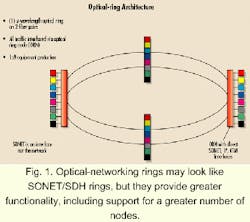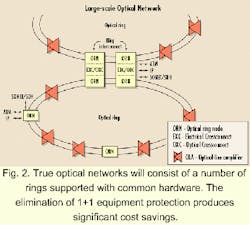DWDM: On the road to true optical networking
Consensus of opinion is a rare event, particularly in the diverse domain of telecommunications. But sometimes a product fulfills industry requirements so completely that its universal appeal is immediately recognized, even if the technology is not unanimously deployed. In other words, telecommunications veterans know a good thing when they see it.
Such is the case with dense wavelength-division multiplexing (DWDM)--the answer to carriers' prayers for additional capacity. The technique greatly magnifies the channel capacity of embedded fiber, and it does so at a fraction of the cost of laying new strands. Carriers have wholeheartedly embraced this network savior.
The story, though, is not what DWDM does for fiber exhaust but what it portends. When DWDM debuted, vendors pointed out that it would ultimately serve as the underpinning for a true optical network. That forecast was generally met with a wink and a nod. While people realized that optical networking could potentially come to fruition, it was kind of a pie-in-the-sky future vision--and point-to-point was the "application du jour."
Yet, the optical-networking visions of DWDM prognosticators have begun to take shape in just the few years after the technology was introduced in mid-1990s. The catalyst, of course, is the unabated appetite for bandwidth created by massive Internet and intranet traffic levels. The demand for bandwidth dedicated to data applications is so vast that by the end of 2000, bandwidth used for Internet protocol (IP) applications will easily overtake that of circuit-switched voice.
Sounds like good news to anyone who is in the business of moving traffic. But while it indeed may be music to the ears of Internet service providers (ISPs), the implications may sound a sour note to the interexchange carriers (IXCs). Today, the dollar-per-bit paid for voice services greatly exceeds that for data and the Internet. This trend will continue to drive the need for IXCs to minimize the cost of adding new bandwidth to their networks. Compounding this situation is that some voice-service revenue will be lost to voice-over-IP as the quality of service on IP networks improves.
The good news for long-haul carriers is that most of them have some of the basic building blocks in place to gravitate to the next level of network efficiency. Most are looking to vendors for assistance in reaching this "promised land" known as optical networking.
Ask any two telecommunications veterans the best way to optical networking, and you're likely to get two different answers. Most agree that it is a worthwhile pursuit--they're just not always sure of their role in the development. That unknown often keeps carriers sidelined for fear they'll make the wrong call.
Actually, there are several pervasive network protocols driving the convergence of topologies and services that is the harbinger of optical networking. IP tops the list. Asynchronous Transfer Mode (ATM) comes in as a strong second because it cohesively unites multiservice networks and bridges the circuit-switched world to the new data-centric age. Digital subscriber line (DSL) energizes the embedded copper base with ultra-high speeds in competition with cable modems, which deliver broadband services directly to the home.
With all of these elements in place the question becomes, "When will optical networks come online and what will they look like?"
Simply defined, optical networking is first the demarcation of equipment protection switching and facility restoration as well as the implementation of facility-based restoration completely and solely in the photonic layer of the transport network. It should offer standardized interfaces to the other network layers to ensure compatibility, sufficient performance monitoring, and fault isolation. In addition, optical-networking applications should include dynamic network reconfiguration, facility-based (not equipment-based) protection of capacity ratio optimization, and centralized restoration.From an architectural perspective, the most valuable first step is to implement optical self-healing rings (see Fig. 1). An optical ring, compared with architectures used in current Synchronous Optical Network/Synchronous Digital Hierarchy (SONET/SDH) ring configurations, provides several advantages such as the ability to support survivable multiple wavelengths without 1+1 high-speed equipment protection. Facility restoration is performed at the photonic layer, so equipment protection can be implemented without any single point of failure.
Since the networking function can be performed at the photonic layer, optical-ring architectures don't place any constraints on the bit rate of the individual channels around a single multiwavelength ring. Thus, terminals, routers, and switches function as "high-speed tributaries" to optical-ring nodes. Since the rings don't rely on the SONET/SDH layer for facility restoration, the number of nodes allowed on the ring is not limited by the SONET/SDH overhead.It should be noted that a ring is not always a network. In most cases, a national or metropolitan network consists of many rings interconnected in a survivable manner via optical-ring nodes (see Fig. 2).
Combined, this architecture would deliver a reliable service that reduces the overall costs of delivering survivable, scalable, and manageable capacity. For example, using optical-ring nodes, service providers can use standardized, low-cost interfaces to the data and SONET/SDH layers via the adaptation modules.
In addition, there are significant savings opportunities provided by the elimination of the 1+1 equipment protection.
According to some industry analysts, there is a dramatic shift in thinking from point-to-point solutions that relieve fiber exhaustion to seriously considering how such an optical network will be built. Optical-networking components that already reside in the network include DWDM, amplifiers, and wavelength converters. To increase momentum, the more challenging elements of optical crossconnects and, particularly, optical switching must come of age.
While DWDM is one of the optical-networking pillars, there is a great deal of functionality that will have to be built into the network. Switching is a key aspect as well as survivability and the ability to provision services and manage the network. The first such components to reach the market will be optical rings and optical crossconnects.
The 20/20 vision provided by hindsight adds another perspective to the optical evolution. Many predict that SONET/SDH will be displaced by a blend of ATM and IP. However, there was an earlier prophecy that predicted ATM over SONET/SDH as the future of networking.
So the issue becomes what will service providers install--IP over SONET/SDH? The short-term answer is probably yes, because there is a lot of SONET/SDH out there. The long-term answer is not clear; there is a lot of functionality actually built into IP that is being replicated in SONET/SDH. So why have this sort of middle layer? The next logical step, then, is to run IP directly over DWDM.
Before carriers take that plunge, however, they will require hard evidence that such a move will pay off. What's more, their DWDM equipment must have what it takes to meet such a direct-data challenge.
Looking back at wavelength-division multiplexing's short history, we started at eight wavelengths, then quickly grew to 16, 32, 40, 80, 96, 128, and now 160 wavelengths. Carriers know that current equipment should provide the capacity they require now as well as a path for upgrades. As a result, they won't have to buy equipment one year and have a stranded investment the next.
Developments announced this past spring indicate that the capability of DWDM equipment to transmit an increasing number of channels over greater distances will continue to grow. For example, last March, Siemens transmitted Gigabit Ethernet traffic over a total distance of 1570 km using its DWDM transport system. That same month, the company sent data down a single fiber at 1.2 Tbits/sec. The system propelled 60 channels, each at 20 Gbits/sec, for a distance of 80 km using an electronic time-division multiplexing (TDM) process. Siemens also is working on a 40-Gbit/sec prototype device. Many vendors are working on similar projects, including the ability to run two optical-networking systems in parallel on a single fiber.
With advancements like these, it is no wonder that the North American DWDM market would make a stockbroker salivate. In 1996, the value of equipment in the marketplace totaled $500 million, according to industry analyst Ryan Hankin Kent. By 1998, that value jumped to $1.9 billion, and for 1999, it's expected to total $2.4 billion just in the United States and Canada.
But the fiscal benefits shouldn't be limited to the coffers of equipment manufacturers. A DWDM system should be measured not only by its channel capacity, distance, or modularity, but also by its ability to save users money and outperform its peers.
As the elements of the optical network come into play, service providers must be nimble enough to step into the game, economically as well as operationally. The following factors place a DWDM system ahead of the pack:
- Density: Equipment should be densely configured to minimize floor-space consumption. That's not to say that components should be so tightly compacted that they push the limits of the BTU rating.
- Distance: Eliminating extra equipment (such as unnecessary regenerators) decreases overall equipment cost and maintenance. When regeneration is needed-after 600 km, as a benchmark figure-the chosen solution should provide substantial cost and space savings compared with traditional SONET/SDH equipment.
- Optical Performance: Examine the performance quality of optical transceivers that perform the optical-to-electrical and electrical-to-optical function. A good regenerator should guarantee a bit-error rate of 10-13 at an optical signal-to-noise ratio of 23 dB.
- Modularity: Modular architectures are best because they allow carriers to minimize their investment and grow their network on an as-needed basis.
The move from today's switching systems to the refined world of optical networking is like the difference between a manual cash register and a scanned pricing device. When optical networking arrives, it will free the operator of laborious, heat-generating, space-consuming devices. Circuits will be provisioned from a central location hundreds or even thousands of miles away. And techniques such as wavelength routing will eloquently restore networks without any service disruption.
For the end user, the greatest change will likely be an enormous increase in the range of multimedia content instantaneously delivered to the PC or TV. Current Integrated Services Digital Network performance may pale in comparison.
As tantalizing as the future appears, there's still plenty of work that lies ahead. Before the first fully optical network is ever lit, it must prove its survivability with a demonstrated method of protection. Many customers require quality of service as a contractual condition; therefore, continuous monitoring of signal strength is essential. Likewise, filtering and bandwidth monitoring are paramount for matters of security.
To sum up, optical-networking elements must be able to emulate many of the functions found in today's TDM network to allow operators to guarantee quality of service to their customers and ensure service availability. Once that's accomplished, the sky's the limit in reinventing applications such as e-commerce, webcasting, e-mail, and telemarketing.
Network operators must respond to the competition by lowering prices and being more responsive to customer needs. New services will provide opportunities for network operators to generate additional revenues, but they must simultaneously focus on constantly reducing costs. They must minimize capital expenditures and operating expense. These reductions can only be achieved by intelligently applying the technology tools that equipment and component vendors make available.
Just as carriers embraced DWDM, expect them to migrate to optical networking at varying intervals and to different degrees. Most certainly, each carrier will rely on the vendor that delivers what is promised. For vendors, this guiding philosophy will prevail: Deliver the technology that fits.
Robert Au-Yang is the manager of systems engineering and Stephan Rettenberger is a senior product manager at the Optical Networks Div. of Siemens Information and Communication Networks. They can be reached at [email protected] and [email protected], respectively.


